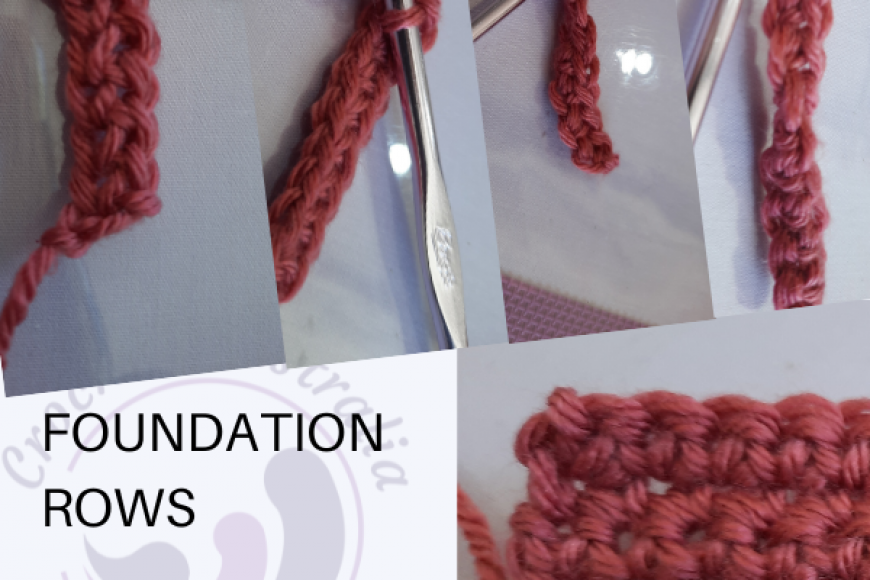Foundation Rows – Different ways to begin your projects
Did you know there are three ways you can work into a foundation chain? Most patterns don’t tell you which way to do it, so you can generally choose the method that works best for you – but beware, each method has its pros and cons. Or you can use the chainless foundation row to avoid this altogether! Read on for the different techniques you could use when you begin your projects.
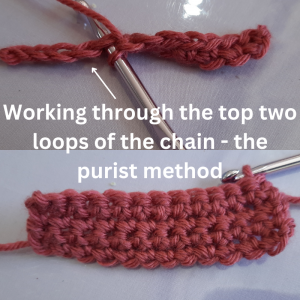 Method 1 – The most purist method is to insert the hook under the top two loops of the chain. This creates a strong base which is suitable for a broad range of projects. However it is also the most difficult method of working into the foundation chain. The finished piece will have an even edge created by the back ridge loop. I find this method often results in a ‘tight’ beginning edge which can make your work bend at the base. To help avoid the bend and difficulty, use a hook one size larger to make the chain – then change back to the size needed for the project once the chains are complete.
Method 1 – The most purist method is to insert the hook under the top two loops of the chain. This creates a strong base which is suitable for a broad range of projects. However it is also the most difficult method of working into the foundation chain. The finished piece will have an even edge created by the back ridge loop. I find this method often results in a ‘tight’ beginning edge which can make your work bend at the base. To help avoid the bend and difficulty, use a hook one size larger to make the chain – then change back to the size needed for the project once the chains are complete.
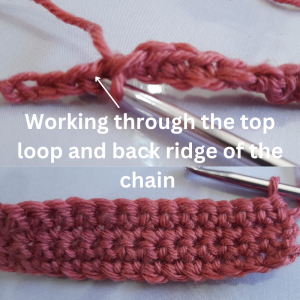 Method 2 – The most common method is to insert your hook underneath the back loop and back ridge loop. This is also the easiest way of working into the foundation chain, this method creates a strong stable base that is also perfect for a variety of projects. It has more stretch then method 1, so is less likely to bend, however the chain can more easily twist when working the first row, so careful attention needs to be paid to that. The finished piece will have a slightly angled edge.
Method 2 – The most common method is to insert your hook underneath the back loop and back ridge loop. This is also the easiest way of working into the foundation chain, this method creates a strong stable base that is also perfect for a variety of projects. It has more stretch then method 1, so is less likely to bend, however the chain can more easily twist when working the first row, so careful attention needs to be paid to that. The finished piece will have a slightly angled edge.
Method 3 – The third option is to work into the back ridge loop. Simply turn the foundation chain over and insert your hook under the single bottom ridge loop. Unlike the two methods above, you are inserting your hook under only one loop. The construction of the chain,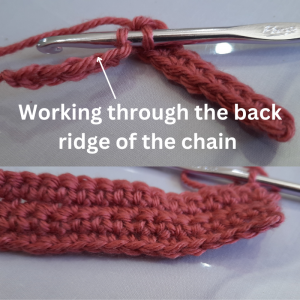 results in this single bottom loop giving the same stability as working under two loops. I find this method can also result in a ‘tight’ beginning edge which can make your work bend at the base. This method is easy to add additional rows on or add an edging as there are clear stitches.
results in this single bottom loop giving the same stability as working under two loops. I find this method can also result in a ‘tight’ beginning edge which can make your work bend at the base. This method is easy to add additional rows on or add an edging as there are clear stitches.
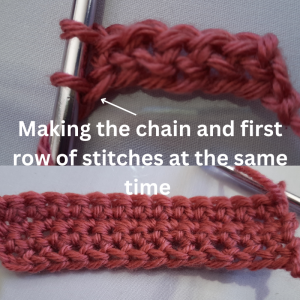 If you are like me and want to avoid having to work into the chains, I love to use the chainless foundation method – where you create the starting chain and the first row at the same time—often referred to as the foundation crochet stitch.
If you are like me and want to avoid having to work into the chains, I love to use the chainless foundation method – where you create the starting chain and the first row at the same time—often referred to as the foundation crochet stitch.
This has the advantage of not only being looser, but it gives the starting row the same stretch as the other rows in your
project thereby avoiding the ‘bend’. It also means that you don’t end up with too few or too many chains at the end of the first row, and you are less likely to twist your working which can happen when working back into the chain. You can
do this with either a double crochet, half treble or treble stitch. This method is also easy to add additional rows on or add an edging as there are clear stitches. This method however isn’t suitable when you are beginning a lace pattern in the first row.
Which method do you like best?

